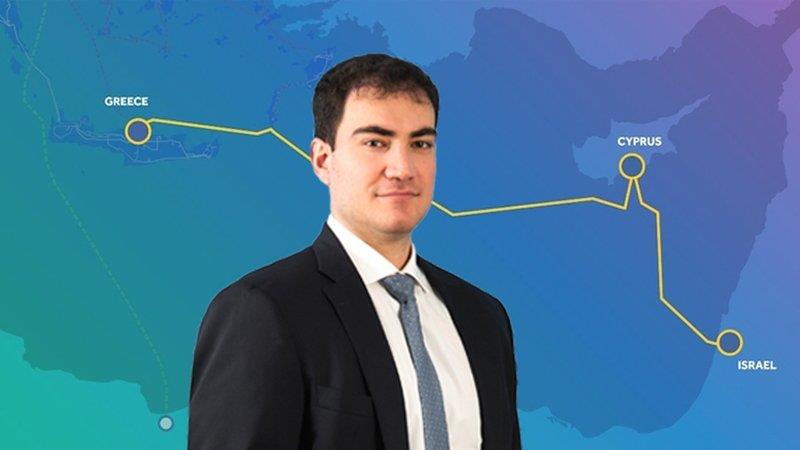As a final decision remains pending on whether the Republic of Cyprus will participate in the stock composition of the company behind the Great Sea Interconnector, Cyfield Group Director George Chrysochos has raised concerns.
Speaking on the subject with InBusinessNews, his comments come as the government is still deliberating whether or not the Republic of Cyprus will be part of the special purpose company created by Greece’s Independent Power Transmission Operator (IPTO), the implementing body for the project of the electrical interconnection of Cyprus, Greece, and Israel.
Chrysochos talks about myths and dangers of the Great Sea Interconnector, raising a series of questions and expressing serious objections to the project.
According to Chrysochos, this is an ambitious and extremely expensive project for the incorrect, as he characterises it, solving the problem of electricity sufficiency and reserves.
As he points out, all countries have reserve production capacity in different regions, in case of unit damage. Which, according to him, costs significantly less than the Interconnector.
As George Chrysochos argues, the Great Sea Interconnector is a project with limited clarity, which raises questions for investors and prevents them from proceeding with further electricity investments.
"Therefore", he wonders, "how will Cyprus create more production, whether with RES or conventional means, for export to other countries?"
Chrysochos’ assessment is that with the high cost of use, the final cost of imported electricity will not be much cheaper than local production.
"Consumers will not benefit drastically, while investments, both in renewable and conventional sources of production in Cyprus will stop. There is a lot of risk for investors. Cyprus' local production will decline and the green goals will never be achieved," he says.
And concluding his statement, the Cyfield Group director emphasises:
"The €657 million in funding from the EU for the Great Sea Interconnector and the remaining €1.4 billion required from private investors and borrowing for the first phase, will not deliver the economic security or environmental benefits the EU is aiming for. Instead, there is a huge sustainability risk that will create higher electricity costs for consumers.
This money could be used to make significant investments in the grid, allowing for greater penetration of Renewables in Cyprus, storage subsidies and back-up power plants.
Comparatively for the cost, with the €657 million of the subsidy, Cyprus could have 800MW of back-up conventional generation, 400MWh of storage with batteries, something which would make the existence of an interconnection pointless".
Read below the complete statement-analysis by the director of Cyfield Group, George Chrysochos (translated from the original Greek):
The Great Sea Interconnector is an idea that started after the 2011 explosion in Mari, which destroyed a significant part of Cyprus' electricity generation capacity for several weeks.
An ambitious and extremely expensive project (estimated at €2 billion for the connection with Greece and €3.2 billion, if Israel is also included) for the incorrect solution of the problem of adequacy and reserve. All countries have spare generation capacity in different regions, in case of unit failure. It costs significantly less than the Interconnector.
The project had a strong lobby based on two European sensibilities and strategies:
- To connect Europe through a common electricity market.
- The "European Green Deal". An ambitious and economically leveling effort to achieve sustainability and save the environment that is currently unnecessary due to RES being cheaper than conventional production.
The Interconnector is based on several myths:
- Cyprus will export electricity from RES.
- Cyprus, Israel and Greece will be able to balance their networks.
- Israel will have emergency backup power generation from Cyprus or Greece.
- Construction and maintenance will be smooth.
Exports:
How will Cyprus be able to export electricity to Greece, when Greece, in October 2022, reported 100% production from RES? Greece has a greater need to export surplus RES production than to import at this stage.
How will Cyprus compete with local production in Greece when the scale of the solar parks is significantly and many times the scale of the solar parks in Cyprus? The breakeven price of a photovoltaic park is directly related to its size (economies of scale).
How will Cyprus compete with Wind Energy in Greece when the wind in Cyprus is minimal compared to Greece?
How will Cyprus export electricity to Israel if Israel has $4 per MMBTU local gas production? Israel's wholesale electricity cost with natural gas at $4/MMBTU is 3 cents/KWh.
Everyone knows that electricity prices in Cyprus have never fallen below 8 cents and are currently at 25 cents (these prices only include variable production costs, eg fuel + carbon gas emissions, net grid, taxes or other contributions).
Cyprus has a severe shortage of electricity generation due to the delay in the import of LNG which will allow independent private producers to enter the market. Also the saturation of our networks does not allow more RES penetration. There is plenty of private interest in investing in both RES and conventional generation, but it is impossible to materialize until LNG reaches the island and the grid upgrade is implemented.
In addition, the Great Sea Interconnector is a project with limited clarity that raises questions for investors and prevents them from making further electricity investments. So how will Cyprus generate more generation either with RES or conventional for export to other countries?
Therefore, Cyprus will be an importer of electricity. Traders will use the cable to import cheaper electricity into Cyprus.
However, Great Sea's high cost means that a very high capital expenditure will be paid to repay loans and investors. Otherwise, the investment will not be attractive to private lenders or equity investors. With higher charges the cable usage will be zero. This is also the reason why the project was not considered viable by the European Investment Bank.
With high usage costs, the final cost of imported electricity will not be much cheaper than local production. Consumers will not benefit drastically, while investments in both renewable and conventional sources of production in Cyprus will stop. There is a lot of risk for investors. Cyprus' local production will decline and the green targets will never be achieved.
Balancing it out:
How can interconnection be a balancing mechanism if the need to export during peak RES production hours is the same in all three countries involved? The developer claims that Cyprus can have a higher penetration of RES due to regulation of the "duck effect" of solar parks, and instead of cuts, we will be able to export the excess energy to Greece.
Greece has a bigger "Duck Curve" issue with even bigger RES penetration! Consequently, Greece has an even greater need for exports. (The Duck Curve refers to a graphical representation of electricity demand from the grid on days when solar energy production is high and demand in the grid is low. When plotted on a graph the lines and curves form a distinctly duck-like shape.)
This will lead to electricity dumping, which is common in northern Europe, with Denmark having high wind penetration. During periods of strong wind, Denmark exports electricity to Germany at negative prices!
Having high imports of electricity either due to cost or dumping destroys local production leading to dependence on foreign production.
An island nation like Cyprus, of which 37% is occupied and under constant security threat, cannot afford to reduce local electricity production and depend on a cable that can be easily damaged or attacked and because of its enormous depth cannot be easily corrected. Energy independence is a top national security issue for all countries.
The high risk of electricity dumping in Cyprus is made even more alarming by the size of the cable. No interconnection cable in the world has been built with twice the capacity of the peak demand of one of the two connected countries. That is, any trader could at any time export to Cyprus 100% of the country's total needs!
Therefore, the regulatory authority in Cyprus should impose a limit on the maximum import of electricity from the Great Sea Interconnector. This means that financing the Interconnection becomes unfeasible and unserviceable.
Exports from Cyprus will be non-existent for the reasons discussed above, electricity trading will be limited, especially if the Great Sea Interconnector is not connected all the way to Israel. Therefore, there will not be sufficient cash flow to service the loan or provide an adequate return to equity investors.
Governments will be forced to socialise the cost of the cable into the utility bills because of the guarantees given and the cost of Cyprus electricity will go up instead of down!
Construction and Maintenance:
No other interconnect cable in the world has been built to such a depth and length. There are known construction difficulties, which make it extremely expensive (at a staggering €2 billion) and very difficult to maintain in case of damage.
This adds to the operational risks, which will seriously jeopardiae the energy autonomy, security and independence of Cyprus.
Alternatives:
The €657 million in funding from the EU for the Great Sea Interconnector and the remaining €1.4 billion required from private investors and borrowing for the first phase will not deliver the economic security or environmental benefits the EU is aiming for. Instead, there is a huge sustainability risk it will create higher electricity costs to consumers.
This money could be used to make significant investments in the Grid allowing for greater penetration of Renewable Sources in Cyprus, storage subsidies and back-up power plants.
Comparatively for the cost, with the €657 million of the subsidy, Cyprus could have 800MW of back-up conventional generation, the 400MWh of battery storage that would make the existence of an interconnection pointless.
(Source: InBusinessNews)









